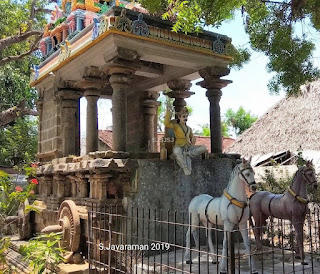 |
| Thiruvarur Kal Ther (stone chariot), TN. stockresearch52.wordpress.com |
.jpg) |
| Thiruvarur ther and temple, Alamy.com |
During this Hindu temple festival time the Delta town of Thiruvarur becomes the center of attraction and the the venue being Sri Thyagaraja Swamy temple located in the center of the town. The annual Azhi ther (Chariot) event is a big event and the festivities span 50 to 55 days. Just like Madurai, it is yet another cultural capital of Tamil nadu where the trinity of Carnatic music-Thyagaraja swami, Muthuswami Dikshitar and Shyama Sastry who composed classical songs were born here.
One of the doyens of Tamil literature Sekkizhar deliberately chose this sacred town of Thyagesa over other towns to introduce his great work - magnum Opus "Periya Puranam". He neither chose Madurai, the capital of Pandya Nadu nor other towns of Chola Nadu Chidambaram, Thanjavur or Uraiyur. Sekkizhar was keen to highlight the divinity, greatness and preeminence of Thiruvarur which was the seat of a legendary Chola king Manu Neeti Chozhan who was well-known for his fair justice, uprightness and integrity.
His son son killed a calf while riding the chariot on the street, though it was not his fault when the grief-stricken mother cow demanded justice by ringing the bell in the matap at the palace he convened the court and heard the case. Quite convinced he ordered his own son to be killed under the wheels of the ratha in a similar manner. Before the execution of the king's oder, God Shiva himself along with other celestial appeared before the ruler and blessed him and resurrected the calf back to life. This way Manu Neeti Chozhan name became synonymous with dispensation of fair justice.
It is quite surprising the saga of Manu Neeti Chozhan is described in the Chola inscriptions vide Vikrama Chola, 1123 CE (SII Vol 5 No. 455). It was being composed as narrated by the presiding deity himself Thyagesa. Priya Viruttan was Manu Neet' son's name.
 |
| King Manuneethi Cholan.Thiruvarur. englishclass diary.blogspot.com |
 |
| cow ringing the bell, Manauneethi Cholan.story collector |
Believed to have lived around 250 B.C. in Southern India, this Chola ruler's dictum was “nobody is above the law and all are equal” King Manuneethi was a righteous ruler who ruled a part of Sri Lanka from 205 BC to 161 BC including the ancient capital of Anuradhapura. Often referred to as 'the Just King,' Mahavamsa states that he ruled his kingdom 'with even justice toward friend and foe, on occasions of disputes. To him, nobles and paupers were equal before law. Fair justice or dharma (manu neethi) was more important than anything else and there was no room for biased verdict because he would make a decision upon hearing the statements from the eyewitnesses. Sometimes, he himself would visit the place of crime or dispute for additional confirmation and satisfaction.
............ Thiruvalluvar from "Thrukkural'
http://www.navrangindia.in/2015/04/the-legend-of-king-manuneethi.html









